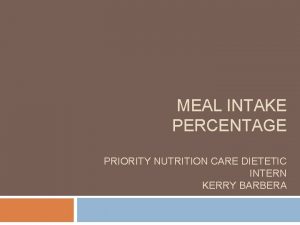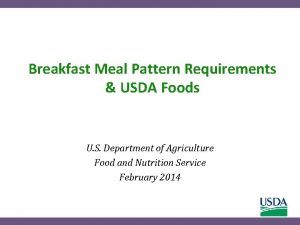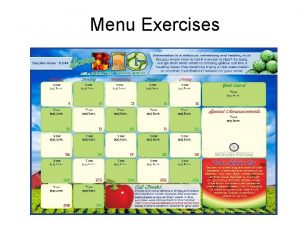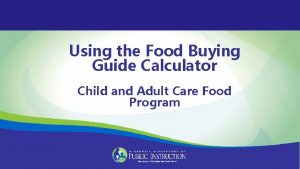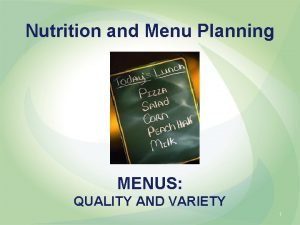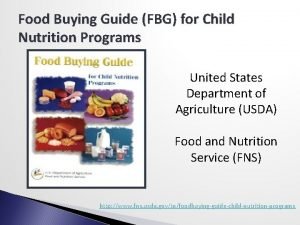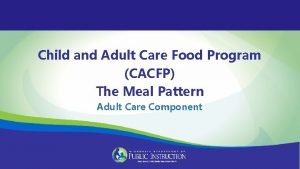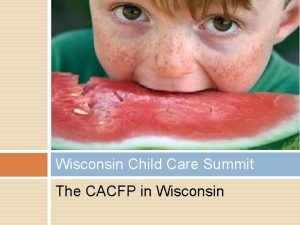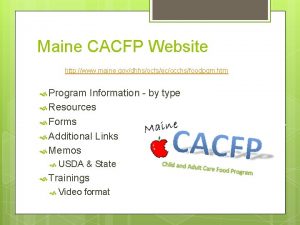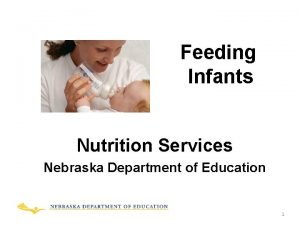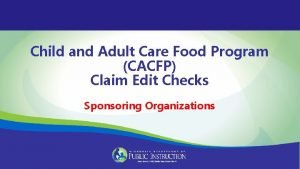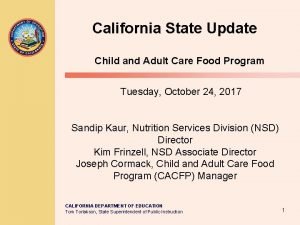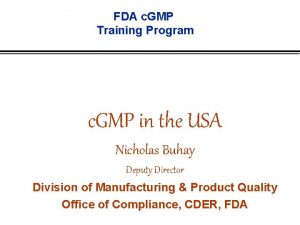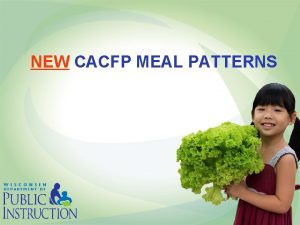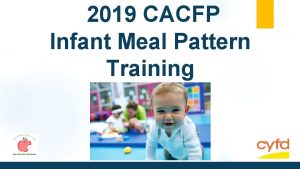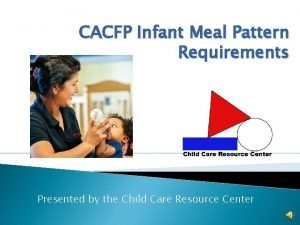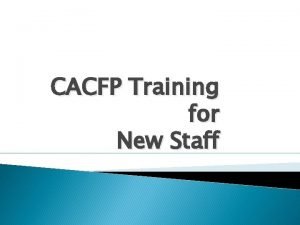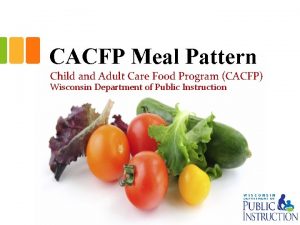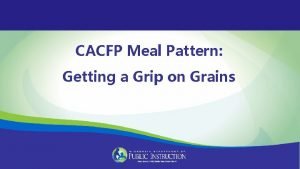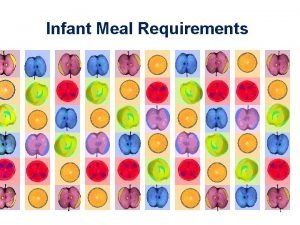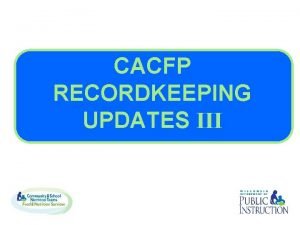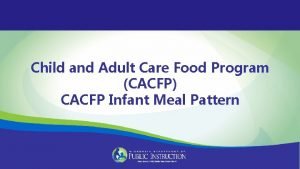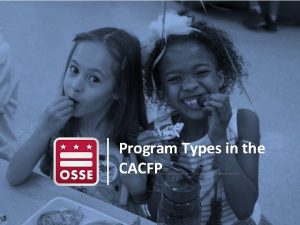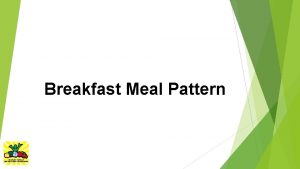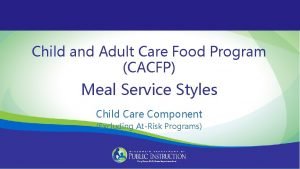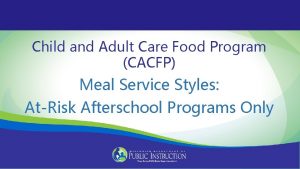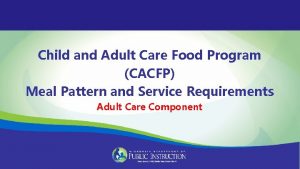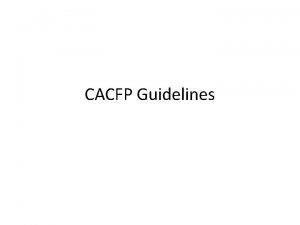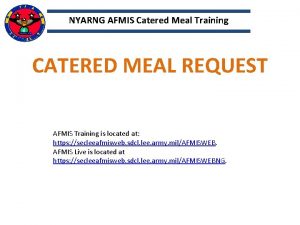Welcome to the CACFP Meal Pattern Requirements Training


























































- Slides: 58

Welcome to the CACFP Meal Pattern Requirements Training – Infant Feeding

Training Materials www. theicn. org/cacfpmp

Child & Adult Meal Pattern Requirements Overview • Wider varieties of protein options • Greater varieties of vegetables and fruits • More whole grains • Less added sugar and saturated fat



Infant Meal Pattern Requirements

Infant Meal Pattern Requirements Overview • Meals are reimbursable when a mother breastfeeds on- site • Features two age groups: Birth-5 months & 6 -11 months • Provides more nutritious meals and snacks o Vegetables & fruits must be served at snack o Juice, cheese food, or cheese spread are no longer creditable o Yogurt & whole eggs are allowable meat alternates

Infant Meal Pattern Age Groups PREVIOUS Birth-3 months UPDATED Birth-5 months 4 -7 months 6 -11 months 8 -11 months

Encourages Breastfeeding • Breast milk is the optimal source of nutrients • Birth through the end of 5 months o Breastmilk or infant formula is the only meal component required o Minimum serving size is 4 -6 oz of breastmilk (or infant formula)

Promotes Developmental Readiness • Delay the introduction of solid foods until around 6 months • Most infants are not ready to consume solid foods until midway through the 1 st year • Introducing solid foods too soon increases risk of obesity

Allows More Nutritious Foods • Foods from all food components may be served around 6 months, when developmentally ready • Breakfast, Lunch, & Supper o Breastmilk or iron-fortified infant formula o Infant cereal, meat/meat alternates, or a combination of both o Vegetable or fruit, or a combination of both • Snack o Breastmilk or iron-fortified infant formula o Grains o Vegetable or fruit, or a combination of both

Focuses on Serving Sizes • Food components beginning with “zero” o Recognizes that all infants are not ready for solid foods at 6 months • By 7 or 8 months, infants should be consuming solid foods from all food groups Serving Sizes 0 -2 oz. 0 -4 tbsp.

Focuses on Eating Habits • Recognizes eating habits may change o Some infants may eat certain foods one week/day, but not the next o Meals & snacks consistent with eating habits should not be disallowed

Breast Milk & Infant Formula

Breastmilk & Infants • Promote breastfeeding by allowing reimbursement when: o a parent/guardian supplies expressed milk § Milk that is produced and expelled from the breast o a mother breastfeeds her infant on- site

Documenting On-site Breastfeeding • Recording the total amount a mother breastfeeds her infant is not required • Acceptable ways to document: o Breastfed on-site o Mother on-site • May use existing forms to reduce paperwork

Serving Expressed Milk • Breastfed infants may not consume the entire serving • Reimbursable: o Offer less than the minimum serving size of breastmilk o Offer additional breastmilk later, if infant will consume more • Feed on demand

Iron-Fortified Infant Formula • Best supplement for breastmilk • Supports healthy brain development & growth • Reimbursable meals may include: o Iron-fortified formula o Breastmilk o Combination of both

Supplying Formula • Offer a minimum of 1 type of iron- fortified infant formula • Formula must be regulated by FDA o May not credit if purchased outside U. S.

Serving Formula • Infants may not drink the entire serving of formula o Reimbursable as long as the minimum serving size is offered • Any leftovers should be properly stored in accordance with local health and safety requirements • Feed on demand

Disabilities & Substitutions • Modifications must be made for infants with disabilities who need accommodations • A medical statement must be on file to receive reimbursement o Explain the need for the modification o Provide guidance for the substitution or meal modification

Fruits & Vegetables

Vegetables & Fruits • Great source of essential nutrients o i. e. , fiber & vitamin C • Minimum serving size: 0 -2 tbsp. • Required at all meals & snacks o Serve vegetable, fruit, or a combination of both o Increases consumption & allows for better acceptance later in life

Juice • Lacks dietary fiber found in other forms of fruits & vegetables • No longer credits toward a reimbursable meal for infants X

Meat/Meat Alternates

Meat/Meat Alternates • Poultry & other meats • Yogurt • Cheese • Whole Eggs • Dry beans

Yogurt • Great source of protein • Minimum serving size: 0 -4 oz • Maybe served during breakfast, lunch, or supper • Must meet the new sugar requirements

Whole Eggs • AAP found no convincing evidence to delay foods considered major food allergens • Whole eggs are now creditable for infant meals • Minimum serving size: 0 -4 tbsp.

Cheese • Minimum serving size: 0 -2 oz • Cheese & cottage cheese • Common examples o Shredded or sliced Swiss, Colby, & Monterey Jack

Cheese foods & cheese spreads are disallowed for infant meals & snacks…

Non-Creditable Cheese Foods • Product packaging states: o “Imitation cheese” o “Cheese food” o “Cheese product” • Common items o Cheese whips o Cheese with pimento o Cream cheese

Grains & Infant Cereal

Grains & Infant Cereals • Iron-fortified infant cereals are often the first solid foods: o Often easiest to digest o Least likely to cause an allergic reaction • Serve at meals & snacks when infants are developmentally ready • Minimum serving size: 0 -4 tbsp.

Snack Meals Only • Bread, crackers, & ready-to-eat breakfast cereals • Ready-to-eat breakfast cereals: No more than 6 grams of sugar per dry oz

Developmental Readiness

Developmental Readiness • Introducing solid foods too early: o cause choking o consume less breastmilk or formula • Serve solid foods when infants are developmentally ready

American Academy of Pediatrics Developmental Readiness Guidelines • Sits in chair with good head control • Opens mouth for food • Moves food from a spoon into throat • Doubles in birth weight

Parent Communication • Working with parents helps to o Ensure newly introduced foods are most ideal o Be consistent with eating habits o Support developmental readiness • Always consult with parents/guardians first before serving solid foods

Optional Written Statement • Request a written statement from parents or guardians: o outlining when & which solid foods to serve • Follows the preferences of parents & guardians

Providing Food Components • Parents/guardians may provide only one creditable food component for a reimbursable meal o i. e. , provide breastmilk = 1 component • Child care providers must provide remaining components

Introducing Solid Food(s) • Once an infant shows signs of developmental readiness, solid foods must be offered • Gradually introduce solid foods o One at a time o Over the course of a few days

Introducing Solid Food(s) (cont. ) • Prepare foods in the right texture and consistency • Observe infants closely for reactions after feeding a new food

Optional Best Practices

Best Practices & the CACFP • Designed to further improve the nutritional quality of all meals • Optional, but highly encouraged o Ensures children & adults get optimal benefits from meals • Non-compliance does not cause: o Meal disallowance o Serious deficiency finding

Infants • Support mothers who choose to breastfeed o Encourage mothers to supply breastmilk o Provide a quiet, private area, that is comfortable, safe, & sanitary

Best Practices Action Plan • Builds on the meal pattern requirements • Shows your commitment to those in your care • Establish & implement a plan CACFP

Documenting Compliance



Sample Infant Documentation • Individual by infant • Includes the infant’s name and date of birth • Documents the amount of food offered at each meal period • Includes specific information on the food items served (i. e. ‘applesauce’ vs. ‘fruit’) • Denotes any parent-provided meal components • Is maintained on site at the center for at least 3 years plus the current year








: Resources Reimbursable Infant Meals http: //www. ride. ri. gov/CNP/Nutrition. Programs/Childand. Adult. Care. Food. Program. as px#21441420 -new-meal-pattern-
 Cacfp record keeping requirements
Cacfp record keeping requirements Priority nutrition care
Priority nutrition care Lunch meal pattern
Lunch meal pattern Breakfast meal pattern
Breakfast meal pattern Cacfp sample menu
Cacfp sample menu Usda food buying guide calculator
Usda food buying guide calculator Daycare cacfp menu template
Daycare cacfp menu template Cacfp food buying guide
Cacfp food buying guide Cycle menus examples
Cycle menus examples Cacfp wi
Cacfp wi Cacfp civil rights
Cacfp civil rights Cacfp wisconsin
Cacfp wisconsin Cacfp maine
Cacfp maine Nebraska department of education nutrition services
Nebraska department of education nutrition services Dpi cacfp
Dpi cacfp Cacfp roundtable
Cacfp roundtable Cacfp administrative manual
Cacfp administrative manual Welcome welcome this is our christmas story
Welcome welcome this is our christmas story Idd cpd requirements
Idd cpd requirements Defense requirements management
Defense requirements management Construction safety association of ontario
Construction safety association of ontario B13l
B13l Fda gmp training
Fda gmp training Welcome to the training session
Welcome to the training session Hát kết hợp bộ gõ cơ thể
Hát kết hợp bộ gõ cơ thể Frameset trong html5
Frameset trong html5 Bổ thể
Bổ thể Tỉ lệ cơ thể trẻ em
Tỉ lệ cơ thể trẻ em Gấu đi như thế nào
Gấu đi như thế nào Tư thế worm breton là gì
Tư thế worm breton là gì Chúa yêu trần thế alleluia
Chúa yêu trần thế alleluia Các môn thể thao bắt đầu bằng tiếng đua
Các môn thể thao bắt đầu bằng tiếng đua Thế nào là hệ số cao nhất
Thế nào là hệ số cao nhất Các châu lục và đại dương trên thế giới
Các châu lục và đại dương trên thế giới Cong thức tính động năng
Cong thức tính động năng Trời xanh đây là của chúng ta thể thơ
Trời xanh đây là của chúng ta thể thơ Cách giải mật thư tọa độ
Cách giải mật thư tọa độ Phép trừ bù
Phép trừ bù Phản ứng thế ankan
Phản ứng thế ankan Các châu lục và đại dương trên thế giới
Các châu lục và đại dương trên thế giới Thể thơ truyền thống
Thể thơ truyền thống Quá trình desamine hóa có thể tạo ra
Quá trình desamine hóa có thể tạo ra Một số thể thơ truyền thống
Một số thể thơ truyền thống Cái miệng nó xinh thế
Cái miệng nó xinh thế Vẽ hình chiếu vuông góc của vật thể sau
Vẽ hình chiếu vuông góc của vật thể sau Nguyên nhân của sự mỏi cơ sinh 8
Nguyên nhân của sự mỏi cơ sinh 8 đặc điểm cơ thể của người tối cổ
đặc điểm cơ thể của người tối cổ Thế nào là giọng cùng tên? *
Thế nào là giọng cùng tên? * Vẽ hình chiếu đứng bằng cạnh của vật thể
Vẽ hình chiếu đứng bằng cạnh của vật thể Phối cảnh
Phối cảnh Thẻ vin
Thẻ vin đại từ thay thế
đại từ thay thế điện thế nghỉ
điện thế nghỉ Tư thế ngồi viết
Tư thế ngồi viết Diễn thế sinh thái là
Diễn thế sinh thái là Dạng đột biến một nhiễm là
Dạng đột biến một nhiễm là Bảng số nguyên tố lớn hơn 1000
Bảng số nguyên tố lớn hơn 1000 Tư thế ngồi viết
Tư thế ngồi viết Lời thề hippocrates
Lời thề hippocrates

